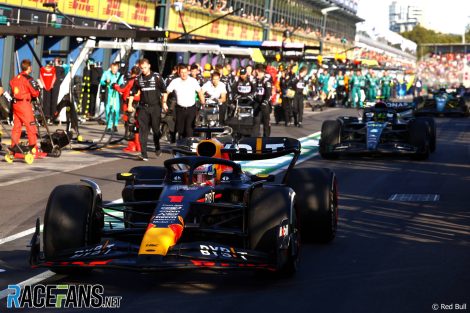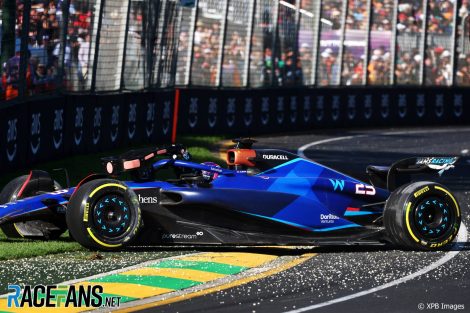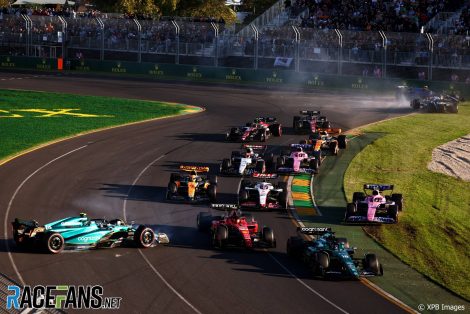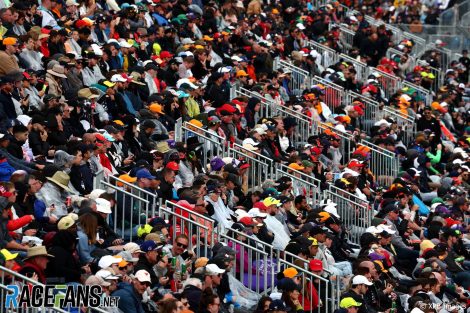Sunday’s Australian Grand Prix in Melbourne was an eventful and controversial one, which finished under Safety Car conditions after three separate red flag stoppages.
Two standing restarts took place – the second of which took place on the penultimate lap, resulting in carnage through the field.
At the end of the race, some were left thrilled, while others were left with a sour taste in their mouth. With decades of experience watching, commentating on and writing about motorsport, what did RaceFans’ writers make of the Australian Grand Prix ‘spectacle’?
The show or the sport?
While F1 lately prefers to use the red flag rather than a Safety Car to for the benefit of ‘the show’, the opposite was once the case. After the Safety Car entered regular use in the nineties it was often deployed instead of a red flag following major crashes as the powers-that-be felt it was better for television to keep the cars running. So when eight cars were eliminated in a huge crash at the start of Melbourne’s 2002 grand prix, the race went on.

Fast-forward 21 years and the same race saw two red flags for separate, single-car incidents. Perhaps by modern standards the quantities of debris and gravel justified this. But, especially in the case of the latter stoppage, it felt like this was done more for entertainment reasons.
But what spoiled the Australian Grand Prix wasn’t only decisions arguably made with an eye on the spectacle. Familiar flaws such as questionable rules and incomprehensible stewarding decisions played a role too.
If the first red flag was thrown to create drama, it failed, as it allowed everyone to change to hard tyres and nurse them to the finish. This was thanks to a feature of F1’s rules drivers have derided for years, which allows penalty-free tyre changes during red flag periods. “The worst rule ever invented,” as Lando Norris once called it.
The final standing restart produced some unfathomable calls from the stewards. Why does Carlos Sainz Jnr deserve a penalty for crashing into Fernando Alonso, when Logan Sargeant isn’t even investigated for crashing into Nyck de Vries, and Pierre Gasly goes unpunished for rejoining the track in the path of other cars, driving to the opposite side of the course and putting his team mate in the wall?
The decision to reset the running order ahead of the final restart smacked of convenience. The pointless spectacle of the field trundling around behind the Safety Car for one more lap served only to grossly amplify the effect of Sainz’s penalty.
Doubtful rules, questionable interpretations and an appetite drama taking priority over the competition. It seems little has improved in the year-and-a-half since the farcical end to the 2021 season. Time for F1 to focus on improving the sport instead of the show.
Keith Collantine
Advert | Become a RaceFans supporter and
Keeping fans in suspense
In no other sport does the outcome of an event get decided hours after it has officially ended. VAR (the Video Assistant Referee) allows footballers to have a decision presented to them at the time if a goal appears offside – whether everyone agrees with the result is a different story. Umpires are helped on a cricket pitch by the other kind of ‘DRS’ (the Decision Review System) yet a game is always decided before the player leaves the green. But motorsport seems to be on another level – and the Australian Grand Prix left even the drivers questioning what on earth had happened.

Far more controversial than the three red flags, which many drivers shared varying views on, was watching another race unfold in which the outcome could’ve changed hours after it finished. Just two weeks ago Fernando Alonso was stripped of third place, before having it reinstated hours later. I had a genuine concern the utterly bizarre ending to the race was once again going to leave us scratching our heads for three hours with journalists furiously refreshing their emails for FIA guidance, especially when a protest was lodged by Haas in a bid to grab third place.
Haas had a point – no matter how far-fetched some critics may have felt the protest was. The trouble is that the order for that roll around after the third red flag has an element of human discretion about it – the FIA could have taken the order from the second safety car line (a line that’s located on the run to the first corner that offers a timing point) but as some crossed it while on their way to crashing out of the race, the FIA went for the restart order. However, instead of just communicating that, it became a guessing game.
Overcompensation perhaps played a part after the events of the 2021 Abu Dhabi Grand Prix, but was I a casual viewer watching this at home, I would not have a clue what was happening. The sport needs to remember it is for entertainment, and the overcomplicated rules and lack of explaining are leaving it exposed to ridicule.
Claire Cottingham
Advert | Become a RaceFans supporter and
Not worth the late night
This was far from the worst event I’ve ever witnessed as a fan of Formula 1. No competitor, marshal, or spectator was gravely injured or worse. It wasn’t two laps of parading in a never-ending monsoon. My family didn’t have to pay hundreds if not thousands to drive to Indianapolis to watch a glorified six-car Bridgestone tyre test. But it wasn’t good either.

I’m not above admitting that I love when chaos disrupts the expected order of world class motorsport. In fact, I love it dearly. Races that produce surprise winners and podium scorers by way of massive mechanical attrition or lapses in judgement from some of motorsport’s brightest minds are what I live for as a fan of Formula 1.
Except that this race’s natural chaos factor was ruined when Alexander Albon’s crash brought out a red flag for barrier repairs and clean-up. George Russell may have been strategically compromised as a consequence, but his power unit was destined to fail spectacularly. Until Kevin Magnussen suffered what we technically termed a ‘skill issue’ out of turn two with just a handful of laps to go, this race was going to be defined by Max Verstappen winning by a crushing margin.
To be certain, any one of the three standing starts was likely to produce the kind of vehicular carnage that spilled from the first chicane down to the hairpin turn four. But the intensity of a two-lap ‘dash for the cash’ with precious championship points and a bigger share of the constructors’ championship prize pool at stake, only caused the probability to spike.
The concept of a race ending under control of a Safety Car feels repulsive to the average American motorsport fan, which is what I grew up around. I can remember vividly when fans at Talladega pelted Jeff Gordon with beer cans after he had the audacity to win a race under caution. Not long after, NASCAR brought the green-white-chequered rule – a staple of grass roots oval racing – into the Cup Series.
IndyCar isn’t above throwing a late red flag in races – even the Indianapolis 500 – to try to ensure a competitive finish. North American sports are famously tie-phobic – and finishing a race under Safety Car is as close to an unsatisfying 0-0 draw as one could have in motorsport.
Australia was an example of how the desire to have a competitive finish at all costs can go wrong. Not gravely wrong, but wrong enough to leave many North American viewers on the East Coast wishing they could have just slept in instead of staying awake until 3:30am to watch… whatever the hell kind of hot mess this was.
RJ O’Connell
Advert | Become a RaceFans supporter and
Celebrating the chaos
It’s time to stand up tall, head held high and declare loudly and proudly: Formula 1 is supposed to be a chaotic sport. Or, at least, more chaotic than it often is.
Twenty 320km/h carbon fibre tubs piloted by some of the most mentally-sharp, competitive minds on the planet pulling five Gs mere millimetres from each other – even around public roads in some cases. When you’re watching week after week, it’s easy to forget how absolutely bonkers a sport this truly is.
Modern F1 is so hyper-professional, so impossibly optimised. Every variable is considered. And from the pit wall to the cockpit, the teams at the very front of the field hardly ever make mistakes. Except maybe Ferrari.

With that comes incredibly reliable cars, drivers who rarely throw it off the road like they did back in the early decades. Over more than 20 grands prix, any natural randomness rarely makes a material difference to the final championship standings as circumstances often average out over the course of the year.
So what is wrong with some genuine chaos, the likes of which we saw in Albert Park on Sunday? No one should ever crave a crash-fest, but whether it was Albon’s race-changing early error or Magnussen’s bizarre shunt that prompted the second suspension, those moments were an excellent reminder that a grand prix is always, always under threat of being transformed in an instant.
That doesn’t mean sporting integrity doesn’t matter – absolutely it does. But it’s also possible for the balance to swing too far towards some ideal of cosmic sporting justice. F1 has already tried aggregate times after red flags to preserve existing gaps when the race stops – a fairer system, sure, but do any of us really want to see that?

Simracing already offers a ‘pure’ form of competition – simply turn collisions off and have all drivers complete the race distance as quickly as possible, free from any risk of crashes or sudden Safety Car interventions. So why is it that those lobbies always lack players compared to others? Because the element of risk always adds excitement to racing, like adding spice to a meal.
It’s not the FIA’s fault that the ‘world’s best drivers’ collided on the final restart. And while Alpine, Haas and others have every right to curse their misfortune, at least the rules were followed this time.
Sunday’s race may not have been palatable for some. But there are 20 races remaining in 2023 – and it’d be astonishing if any are as manic as Melbourne. So let’s embrace a little bit of chaos in Formula 1. Let’s keep the spice.
Will Wood
Advert | Become a RaceFans supporter and
















